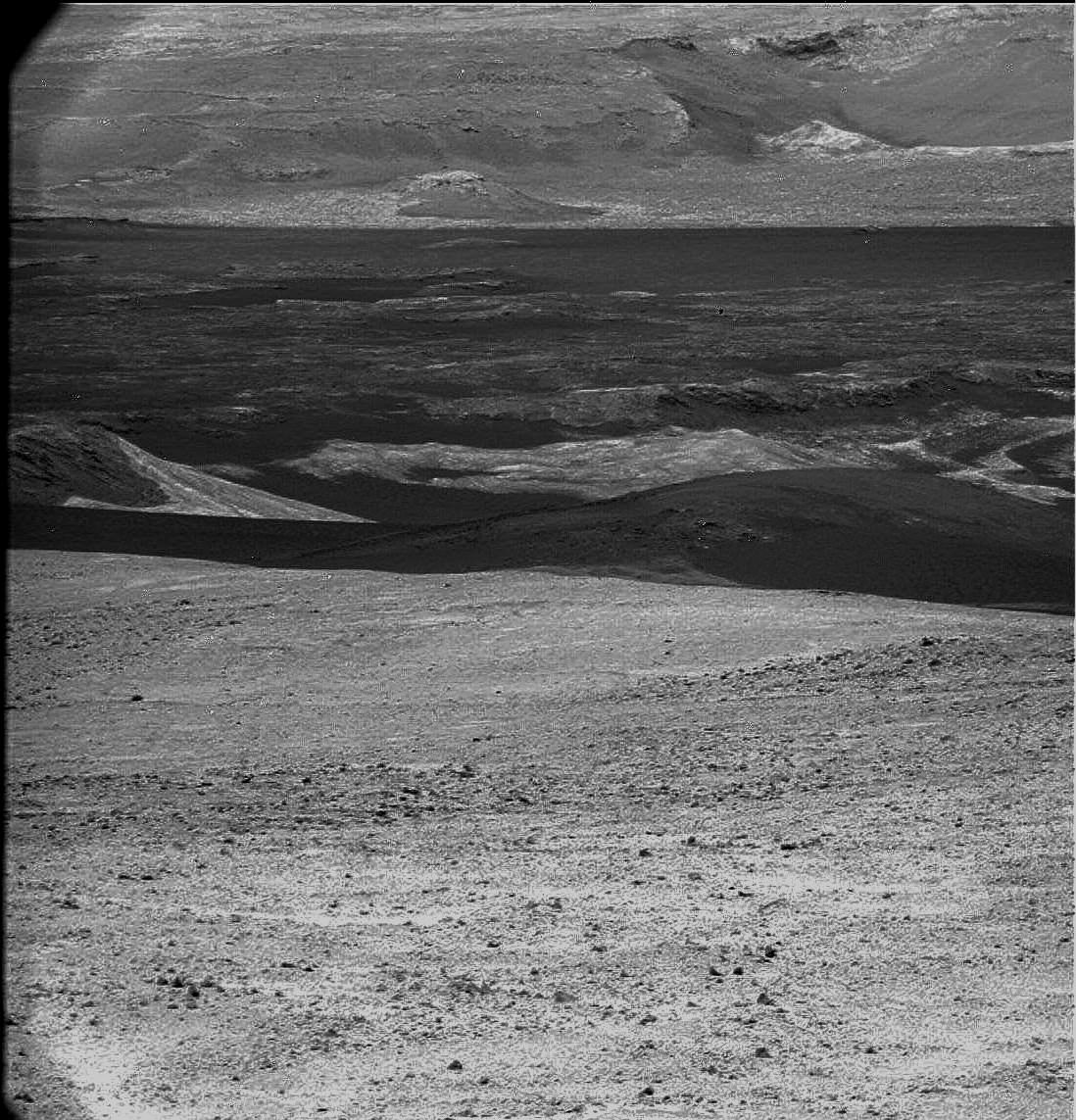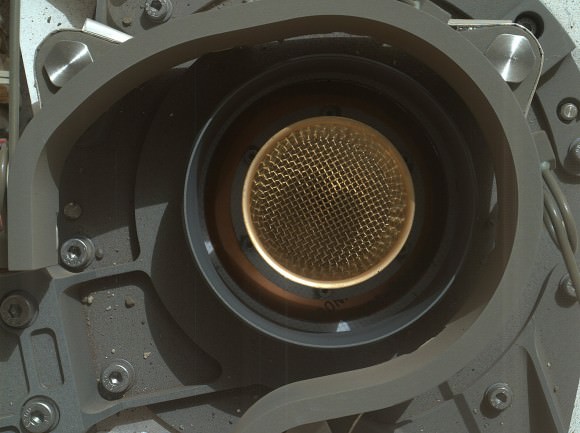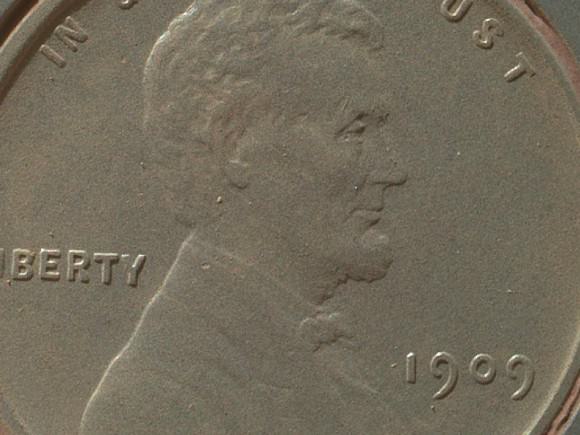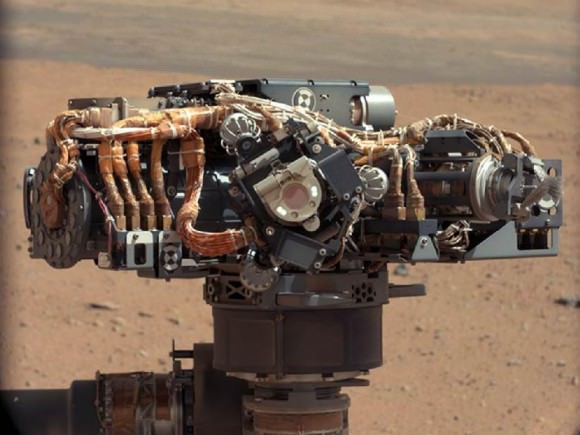Take a deep breath because this new panorama from Mars enthusiast Stu Atkinson will take it away.
“Anyway, a whole bunch of these came down, like I said, and to my delight they all linked up to form a big, biiiiiiiig panoramic mosaic,” said Stu on his blog “The Gale Gazette.” “And here it is. Obviously you’ll need to click on it to enlarge it… and I’ll warn you, it’s a big image, you can kiss the next few minutes goodbye because you’ll be panning around it for a while…”
Zoom in and you can see actual rocks. Click that little button at the right of the toolbar and Mars will take over your screen.
So far, Curiosity has rolled across a barely dusty plain in Gale Crater. Here’s a look of things to come. In black-and-white image from Curiosity, there appear to be big dunes to cross to get to the foothills of Aeolis Mons, or Mount Sharp.
A black-and-white but still breathtaking view of the dusty terrain between Curiosity’s current location and the foothills of Aeolis Mons, or Mount Sharp. Credit: NASA/JPL/Stu Atkinson
Curiosity has nearly finished robotic arm tests. Once complete, the rover will be able to touch and examine its first Mars rock.
“We’re about to drive some more and try to find the right rock to begin doing contact science with the arm,” said Jennifer Trosper, Curiosity mission manager at NASA’s Jet Propulsion Laboratory in Pasadena, Calif, in a press release.
This image from NASA’s Curiosity rover shows the open inlet where powered rock and soil samples will be funneled down for analysis. It was taken by the Mars Hand Lens Imager (MAHLI) on Curiosity’s 36th Martian day, or sol, of operations on Mars (Sept. 11, 2012). MAHLI was about 8 inches (20 centimeters) away from the mouth of the Chemistry and Mineralogy (CheMin) instrument when it took the picture. The entrance of the funnel is about 1.4 inches (3.5 centimeters) in diameter. The mesh screen is about 2.3 inches (5.9 centimeters) deep. The mesh size is 0.04 inches (1 millimeter). Once the samples have gone down the funnel, CheMin will be shooting X-rays at the samples to identify and quantify the minerals.
Engineers and scientists use images like these to check out Curiosity’s instruments. This image is a composite of eight MAHLI pictures acquired at different focus positions and merged onboard the instrument before transmission to Earth; this is the first time the MAHLI performed this technique since arriving at Curiosity’s field site inside Gale Crater. The image also shows angular and rounded pebbles and sand that were deposited on the rover deck during landing on Aug. 5, 2012 PDT (Aug. 6, 2012 EDT).
Two science instruments, a camera called Mars Hand Lens Imager, or MAHLI, that can take close-up color images and a tool called Alpha Particle X-ray Spectrometer (APXS) that can determine the elemental composition of a rock, also have passed tests. The instruments are mounted on a turret at the end of the robotic arm and can be placed in contact with target rocks. The adjustable focus MAHLI camera produced images this week of objects near and far; of the underbelly of Curiosity, across inlet ports and a penny that serves as a calibration target on the rover.
This close-up image shows tiny grains of Martian sand that settled on the penny that serves as a calibration target on NASA’s Curiosity rover. The larger grain under Abraham Lincoln’s ear is about 0.2 millimeters across. The grains are classified as fine to very fine sand.
The Mars Hand Lens Imagery (MAHLI) on the Curiosity rover taken by the Mast Camera on the 32nd Martian day, or sol, of operations on the surface. Engineers imaged MAHLI to inspect the dust cover and to ensure that the tool’s LED lights are functional. Scientists enhanced the image to show the scene as it would appear under Earth’s lighting conditions. This helps in analyzing the background terrain.
Check out more images from the Mars Science Laboratory teleconference.
Image credit: NASA/JPL-Caltech/MSSS





Firstly. Good to see the Mars love-feast continuing to relentlessly rumble on. “Universe Today” should consider having an off-shoot site like “Mars Today” to keep all the fanboys forever happy. Yet again we see only the hyped positive-slanted pro-US / pro-NASA articles without any of the controversial problems or issues that are facing Curiosity’s mission. Everything, it seems is AOK and we don’t want to listen to anything else!
Also, the title says; “Say Ahhh to Mars”. It should read “Say Ohhh to Mars.” Here’s why…
One important current issue, for example, is the possibility the Curiosity has the real chance of contaminated in the pristine Martian environment with bacteria. According to the wider media, some nitwit didn’t clean a drill bit, and now this rover has to avoid water and ice at all cost in case it contaminates the soil with Earth-based life. Funny too, that if the rover finds evidence of Martian life, they will have to make sure it wasn’t from Earth first.
NASA and the US authorities continue to discount the issue as minor, when it is probably one of the worst stuff-ups in space exploration history. Mars has been isolated for four billion years or so, and then mindless humans come along (Americans boldly claiming to do this for ‘all mankind’), and then produce their amazing contamination scare by possibly changing the Mars environment catastrophically to scientific investigation forevermore.
Seeing these pictures and panoramas almost makes you want to shed tears just thinking of what these careless cavaliers might have done!
I am interested to see how important my issue raised above is to people (and see if I am out-of -touch here.)
It might be an idea to do a little survey using the up and down arrows with the comments to this actually post.
1) Click up if you think the contamination is stuff-up or
2) Click down if you think it doesn’t matter
(Here) Thanks, SJ.
That first picture looks like summertime. Glad the rover dosn’t have to muck through snow to explore mars geological history. There ought to be some kind of X-prize for the first person to grow something in a martian climate. Do you actually believe it could be that easy! It would at least take some kind of extremeofile minus the air or water. Can one earthy organism even exist without multiple factors in its favor.
Curiosity Could be Contaminated with Earth Bacteria, Threatening Search for Mars Life.
To quote this article;
In another quote in the Los Angeles Times;
Not my words BTW, American sources are saying this!!!!
We wrote about the contamination issue back in June: http://www.universetoday.com/95819/curiosity-and-the-issue-of-planetary-protection/
Oops!! How does one remove so much egg on one’s face?
I did look via Google before writing my responses here. I also didn’t see this Universe Today article. I have no excuses, I should have checked this out more carefully.
Click Here.
http://www.dlr.de/dlr/presse/en/desktopdefault.aspx/tabid-10172/213_read-3409/
@SJStar:disqus : You can be sure the issue is very well known among the scientific communities. My microbiologic scientific peers were disgusted (to say the least) when I told them about this issue as it first surfaced earlier this year!
Apolo 12 landed by the surveyor spacecraft which was not sterilised. The camera was taken back to Earth and found to have streptococcus mitis bacteria in it after 31 months on the moon, unfortunately the naysayers say it was contaminated….
If you don’t want to contaminate mars don’t send mandkind they are the most filthy thing to e!
I clicked up , not because i think it’s a bad thing to seed life, who knows, maybe we started out as a dirty drill bit. The problem is, if we find bacteria on Mars we won’t know where they came from which just screws up the whole science of life hunting. I predict we will find micro organisms of non-terrrestrial origin throughout the solar system and when we do we don’t want the jackasses braying about contamination.
What is the point of the poll – to force people to either agree with you or appear to be apathetic to the issue? The contamination is a big mistake. No one is hiding it or refusing to talk about it. It wasn’t intentional and there were protocols and procedures in place to try to avoid it. Unfortunately, something went wrong. What do you expect NASA to do? I hope they have investigated the break-down and revised the necessary procedures. You give the impression that you think NASA should admit flagrant disregard, fire all the scientists and engineers (at least the American ones) and get out of the space exploration business.
As pointed out by @zkank, there have been other probes sent with a higher probability of contamination. The catastrophe you are shedding tears over happened long ago.
The discussion I would like to see is if or how will we differentiate the origin of any life detected on Mars.
Maybe you haven’t been keeping up, but Curiosity’s mission isn’t to look for life.
NASA made this very clear at the beginning, and there were at least two articles posted at UT, too.
What is the point in keeping Mars pristine, with so many valid discussions for terra-forming it?
Are you upset at the tread marks, too?
You are naiive to think that a neglected drill bit should be viewed as a disaster contaminating Mars in lieu of all the other unsterilized probes that have landed there in the past.
Stop fretting, don’t shed any tears, and try to get some sleep.
Your posts are too political and anti-American to be taken seriously.
Actually it is a condition placed on by the United Nations, in which, the US is a signatory.
Examples of NASA papers on contamination include;
Introduction to Planetary Protection and Biological Contamination
Planetary exploration in the time of astrobiology: Protecting against biological contamination
To quote the Planetary Protection Policy (U.S.A.). [http://www.ncbi.nlm.nih.gov/pubmed/11538131]
Seeing the expectant negativity shows the lack of intelligence of some…
Americans make a mistake and they always make excuses, then express denial, or better still, just ignore it. Makes you wonder…
Oh. If his is too complex for some, then read http://en.wikipedia.org/wiki/Planetary_protection
As for American trust on this subject, here is an interesting paper; Mars Sample Return: Do Australians trust NASA?
To quote S. Joyce, , C.S. Tomkins, P. Weinstein (1997);
(These are not my words, BTW.)
Wow, citations and its peer reviewed. Me, anti-American, I don’t think so.
I shouldn’t engage you again on this one, but there’s a few points I can’t let pass.
First, anyone who cites Wikipedia as a source of fact has already lost the debate.
Second, the “Do Australians trust NASA” poll is completely ridiculous!
It was an online poll!
Was it among polls to vote for contestants on Dancing with the Stars?
Australia’s Got Talent?
Was it taken in the middle of the night offered to the Lunatic Fringe, who already suspect NASA is withholding evidence of Venusian civilizations?
Third, I find this beyond mere coincidence – are you, SJStar in Australia, the same person as S.Joyce in Australia who helped pen the book you cite for the above ridiculous poll, “Advances in Space Research”?
You’re not shamelessly self-promoting your book ($31.50) here, are you?
“You’re not shamelessly self-promoting your book ($31.50) here, are you?”
Wow. Hell no. I am not associated with any of the individual, S. Joyce or promoting anything. I have just made comments and quotes to support my arguments. I’m more taken back with the longest bow I’ve ever witnessed.
Oh. The reason for the study was the that MLR was to be considered in land in Australia, and they were judging the resistance to the idea.
According to the JPL pdf report, American Institute of Aeronautics and Astronautics, pg. 5 of Matousek, et al. “A Few Good Rocks:
The Mars Sample Return Mission Architecture.” (1998)
at http://trs-new.jpl.nasa.gov/dspace/bitstream/2014/20319/1/98-1233.pdf“Although at this time we plan a landing in Australia, other options are being investigated.”
It is interesting to note that you started this comment thread by complaining about yet another Mars article only to be moved to tears a few sentences later. When several of your posts on UT involve statements similar to “Americans make a mistake and they always make excuses, then express denial, or better still, just ignore it. Makes you wonder…”, it is understandable that you may be labelled as anti-American. I have seen more than one post from you flogging UT for being too American. If you are unhappy with the product, feel free to find a space news site with a more international flavor. Start your own news site and write all the hyper-critical, condescending articles you feel necessary.
Yet another review by NASA (2012).
Office of Planetary Protection
This talks about the procedures for biological sterilisation of spacecraft. It says;
In Curiosity’s case, the horse has already bolted!!
Most of these treaties aren’t worth the paper they’re written on.
The moment someone puts boots on the ground in Mars and takes a piss is the moment this treaty is D E A D . The low gravity of Mars would make for a very long leak.
This is the classic example of an unenforceable treaty since to stop someone from contaminating / bringing life to another world requires having some way to back up those words. And right now the only thing to back those words is bullshit.
….so America ignoring a treaty that is a signatory is then perfectly OK? Hypocrites comes to mind…
Dreadful comments like this are the antithesis of the ol’ ugly American. America might be a powerful country but this kind of arrogant superior complex is growing a little thin. Where is humanity’s actual responsibility to the environment, ecology, the world or even on Mars?
Leaders of the world? IMO can’t end too soon if this the kinds of stinking opinion that are collectively agreed too.
(The poor language is unacceptable too, BTW.)
When did I use the words “America” in my previous comment?
I am not trying to defend the percieved “contamination”. In fact I’m saying the rationale of the treaty is laughable . There have been rocks going back and forth between Mars and Earth for billions of years , “contaminating” both planets with organic material.
Also time will prove me right – it is impossible to back this treaty up since it is unenforcable. The first human to visit Mars WILL contaminate it irreversibly. What do you propose to do then ?
Even executing them and burying or cremating the remains will increase the “contamination”.
In the long run , this treaty will is yet another one not worth the paper it is printed on.
This whole “incident” just seems to be a golden oppurtunity for you to indulge in some much wanted US-bashing.
I agree we need more Mars material here. Daily Mars material here.
Regarding the top panorama scene, I’m surprised how rounded some of the float is in that photo.
Did anyone else not something strange in this image? (I am not suggesting little martians – please youtubers don’t jump to conclusions just yet.. but…) If you stay at half zoom level on the color panoraminc, about two-thirds up from the bottom of the entire image above 1.1 whole frames as you scroll horizontally there are a series of repeating dark blobs.
Each blob appears not much bigger than one of the larger rocks.
It repeats regularly just off every full frame at 50% zoom.
Is this an artifact of the imaging/stiching or could there be something else at play??
Particularly interested if Stu Atkinson may be reading this if he could please clarify if these features were on the original (individual) images? And whether they may be imaging artifacts or more excitingly actual strange dark objects recurring at regular intervals?? (They are almost absolute black as pixels and each one takes a radius of tens of pixels in diameter).
Thanks.
Best,
Wezley
ps. when viewing the image here on this site at 50% zoom level, they are 20% from the top of the image and appear not much bigger than a bold full stop .
Damn! I was hoping for some extremely cold Martian critters! Darn technies! 🙂
I had a hard tome to find what you were referring to.
But I think you are referring to something that appears to be a dust speck on the lens or dead pixel on the CCD. This panorama is crated by stitching different photo’s next to each other. So you get the same dust speck at different places.
Awesome . The clarity of the images is astounding !
I can’t belivee the pictures are from Gale crater more than 100 million km away. They look like something right out of the atacama.
Seeing these is like imagining all our wet scifi dreams come true !